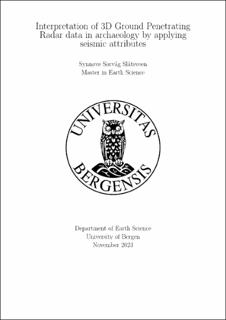Interpretation of 3D Ground Penetrating Radar data in archaeology by applying seismic attributes
Master thesis
Permanent lenke
https://hdl.handle.net/11250/3121488Utgivelsesdato
2023-11-20Metadata
Vis full innførselSamlinger
- Department of Earth Science [1050]
Sammendrag
Ground Penetrating Radar (GPR) has emerged as a widely employed geophysical method in archaeological studies, with recent advancements leading to large-scale, high-resolution surveys. The processing techniques applied to GPR data bear significant correlation to those used in seismic analysis. In recent times, there has been a growing interest among archaeologists in employing seismic attributes for GPR interpretation. Seismic attributes have long been a staple in reservoir characterization within the field of seismic exploration. This study aims to encourage archaeologists to leverage these attributes for enhanced interpretation of archaeological structures using GPR data. To achieve this, the study delves into fundamental GPR principles, the process of data acquisition and processing, and an in-depth review of each attribute utilized in this thesis. Additionally, a systematic workflow is established to extract attributes and relevant information from GPR data, aiming to improve the interpretation of archaeological structures.
Furthermore, the integration of seismic attributes with GPR data for archaeological analysis has shown promising potential. Leveraging insights from seismic methodologies, the variance-coherence based attribute displayed promising outcomes across all three archaeological structures. Additionally, other attributes and methods have shown promising results. These findings may serve as a valuable resource for future studies aiming to interpret archaeological features through GPR data, potentially enhancing the visualization and understanding of other structures investigated in this thesis.
